Television broadcasting is a process of transmitting audio and video content over the airwaves to a large audience. The content can be live or pre-recorded and is transmitted using radio frequency signals. This allows TV sets in households to receive the signal and display the content. This article will discuss the various aspects of television broadcasting and how it works.
Anatomy of a Television Broadcast
A television broadcast can be broken down into several components, each essential in delivering the content to the viewer. These components are:
Content Generation: This involves the creation of the audio and video content that will be transmitted. This can be done through live broadcasts or the production of pre-recorded content.
Studio Equipment: This includes the cameras, microphones, lighting, and other equipment used to capture the audio and video content.
Encoding and Transmission: This involves converting the audio and video signals into a format suitable for transmission and then sending the signs to the transmitter.
Transmitter: This is the device that sends the signals over the airwaves. It uses high-powered radio frequency signals to reach a large audience.
Antenna: This device receives the signals from the transmitter and sends them to the TV set.
TV Set: This device receives the signals from the antenna and displays the content on the screen.
The Broadcasting Signal
Television broadcasting uses radio frequency (RF) signals to transmit audio and video content. The RF signals are modulated, meaning that the audio and video information is combined with the carrier signal, allowing it to be transmitted over the airwaves. The modulated signal is then transmitted using a high-powered antenna and sent over the airwaves to the TV sets in households.
The transmission of the RF signals occurs in a specific frequency band, known as the VHF (Very High Frequency) or UHF (Ultra High Frequency) band, depending on the country. In the US, the VHF band is used for channels 2 through 13, while the UHF band is used for channels 14 through 69.
Reception and Decoding
The antenna receives the RF signals on the TV set, which converts the signals back into an electrical signal. The TV’s tuner then processes the electrical signal, which decodes the signal and separates the audio and video components. The audio and video signals are then sent to the TV’s speakers and screen, respectively, to be displayed.
Analog and Digital Broadcasting
Television broadcasting has gone through several technological advancements over the years, one of the most significant of which was the transition from analogue to digital broadcasting. Analog broadcasting uses an analogue signal to transmit the audio and video content, while digital broadcasting uses a digital signal.
Analog broadcasting is susceptible to interference and signal degradation, resulting in poor-quality images and sound. Digital broadcasting, on the other hand, provides a cleaner signal with a higher resolution and better sound quality. Additionally, digital broadcasting allows for the transmission of multiple channels in a single frequency band, increasing the number of channels available to the viewer.
The transition from analogue to digital broadcasting was completed in the US in 2009, and many other countries have since made the switch.
HD Broadcasting
High Definition (HD) broadcasting is a type of digital broadcasting that provides a higher-resolution image and improved sound quality. HD broadcasting allows for content transmission with a resolution of 720p or 1080p, compared to the standard definition resolution of 480i or 576i.
Frequently Asked Questions (FAQs)
What is television broadcasting?
Television broadcasting transmits audio and video content over the airwaves to a large audience using radio frequency signals. This allows TV sets in households to receive the signal and display the content.
How does television broadcasting work?
Television broadcasting works by converting the audio and video content into a format suitable for transmission, sending the signals over the airwaves using a transmitter, receiving the signals with an antenna, and then decoding the signal and displaying the content on the TV set.
What are the components of a television broadcast?
The components of a television broadcast include content generation, studio equipment, encoding and transmission, transmitter, antenna, and TV set.
What is the difference between analogue and digital broadcasting?
Analog broadcasting uses an analogue signal to transmit the audio and video content, while digital broadcasting uses a digital signal. Digital broadcasting provides a cleaner signal with a higher resolution and better sound quality and allows transmitting multiple channels in a single frequency band.
What is HD broadcasting?
High Definition (HD) broadcasting is a type of digital broadcasting that provides a higher-resolution image and improved sound quality. It allows for content transmission with a resolution of 720p or 1080p, compared to the standard definition resolution of 480i or 576i.







